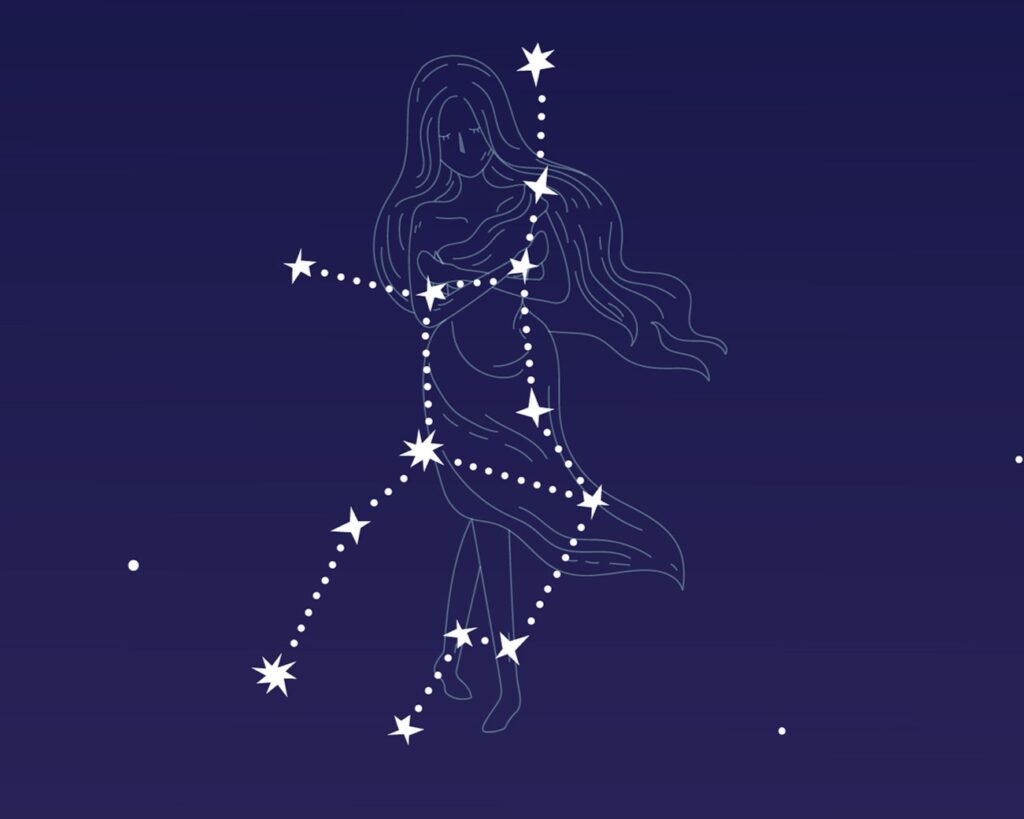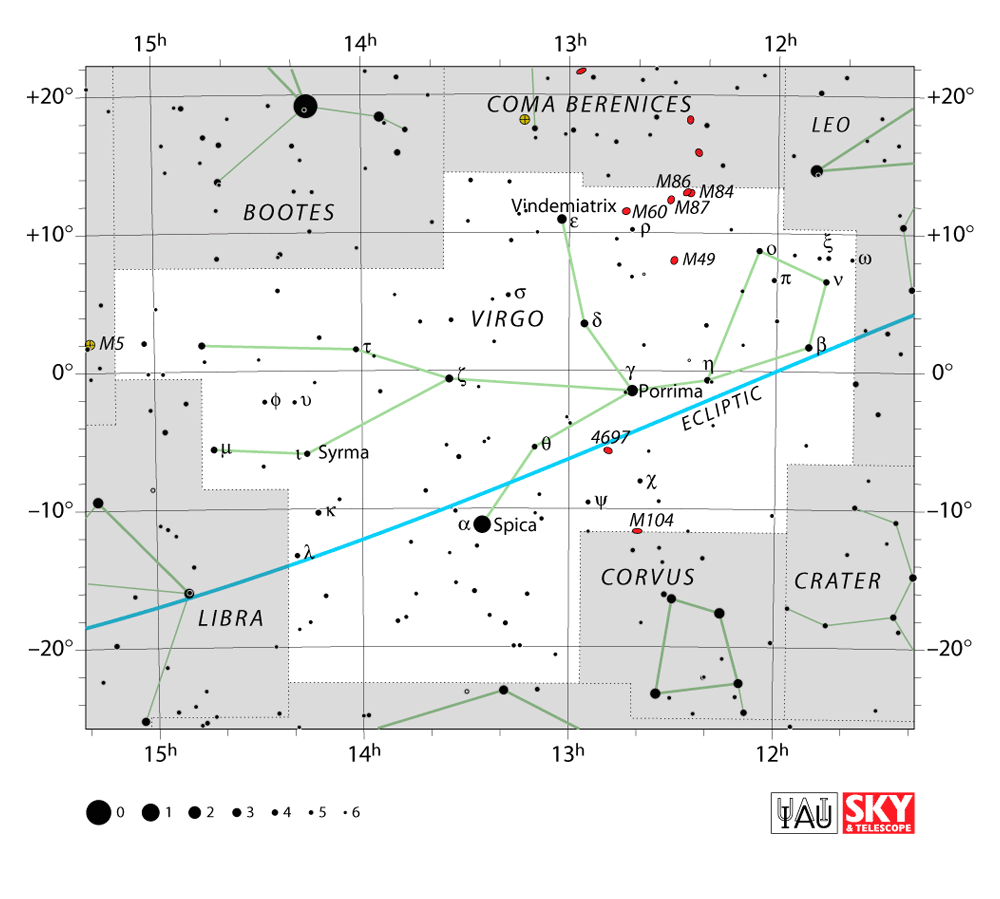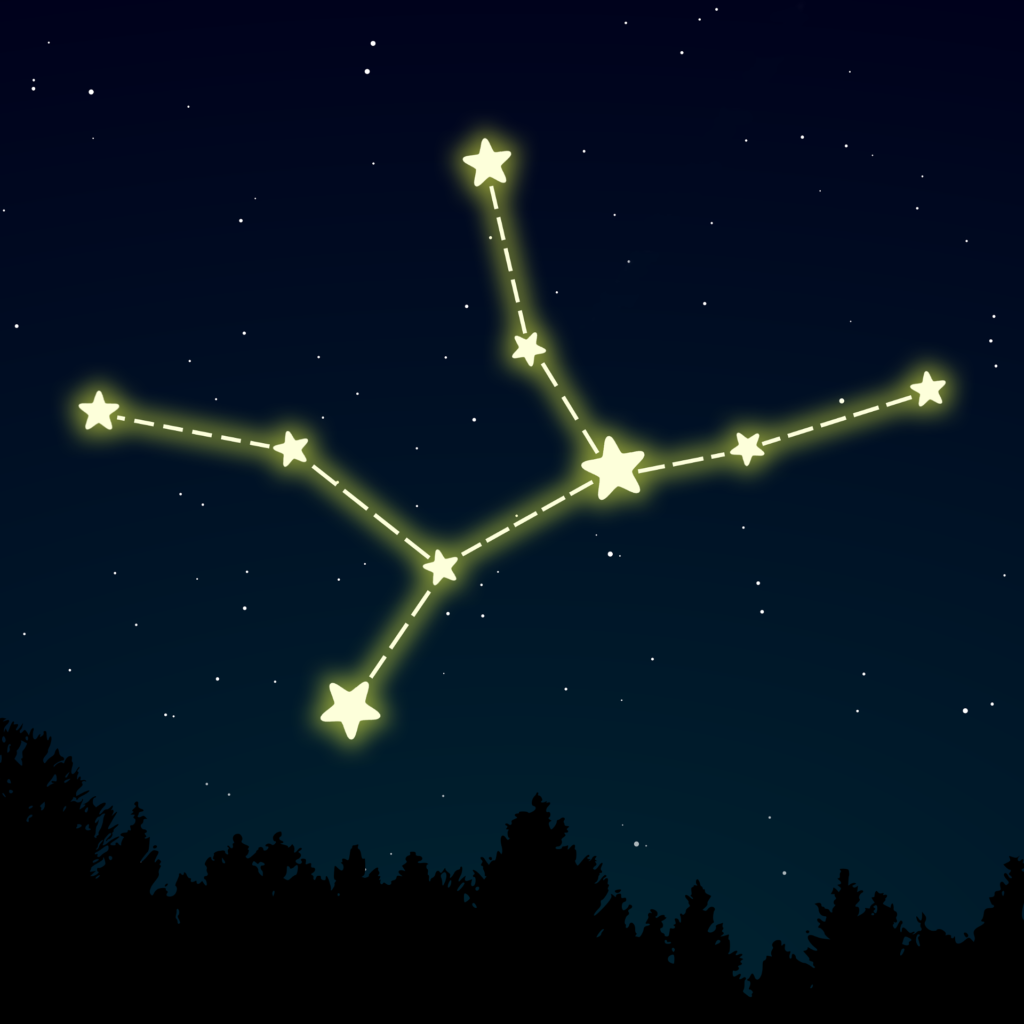Stargazing with Virgo
© freepik/tartila
The Virgo constellation, nestled between Leo to the west and Libra to the east, is a sprawling and significant feature of the night sky. One of the 88 recognized constellations, The ecliptic intersects the celestial equator within this constellation and Pisces. Underlying these technical two definitions, the Sun passes directly overhead of the equator, within this constellation, at the September equinox. The constellation can be easily found through its brightest star, Spica.
Due to the phenomenon of precession, the initial point of Libra, also identified as the autumn equinox point, is situated within the boundaries of Virgo in close proximity to β Virginis. This marks one of the celestial locations where the celestial equator intersects the ecliptic—the other point being the initial point of Aries, now positioned in the constellation of Pisces. Between the 18th century and the 4th century BC, the Sun aligned with Libra during the autumnal equinox, transitioning to Virgo thereafter. Over time, this point is anticipated to shift into the neighboring constellation of Leo around the year 2440.
Represented as a maiden or goddess, Virgo is often associated with themes of fertility and harvest. Within its boundaries lie a wealth of celestial wonders, including the bright star Spica and the Virgo Cluster—a vast collection of galaxies. As a part of the zodiac, the constellation plays a crucial role in astrology, marking the Sun’s path during certain times of the year.
Virgo, encompassing a vast expanse of 1294 square degrees, ranks as the second-largest constellation in the night sky. Among the 15 equatorial constellations, it resides in the third quadrant of the southern hemisphere (SQ3) and offers its celestial spectacle to observers at latitudes between +80° and -80°. Within the constellation’s borders, 17 stars have been bestowed with names. Recognized and officially approved by the International Astronomical Union (IAU), these stars include Elgafar, Flegetonte, Gar, Guahayona, Heze, Kang, Khambalia, Lich, Malmok, Minelauva, Mönch, Porrima, Spica, Syrma, Vindemiatrix, Zaniah, and Zavijava. The abundance of named stars within Virgo adds to its allure and prominence in the cosmic tapestry.
HISTORY OF VIRGO

The Virgo constellation has a rich and diverse history deeply entwined with mythology, astrology, and ancient civilizations. In Greek mythology, it is often associated with the goddess Demeter or her daughter Persephone. Demeter, the goddess of agriculture, represents the harvest and fertility, while Virgo is depicted as a maiden holding a sheaf of wheat, symbolizing the bounty of the Earth.
In Babylonian astronomy, the constellation was linked to the goddess Shala, who was associated with fertility and the harvesting of crops. The presence of the constellation in the night sky was often linked to agricultural cycles and seasonal changes.
The ancient Egyptians also had their interpretation of Virgo, aligning the constellation with the goddess Isis. She was revered as a symbol of motherhood and fertility, emphasizing the nurturing aspect of the constellation.
Virgo’s association with agriculture and fertility persisted through various cultures, including the Roman era, where the goddess Ceres was linked to the constellation. This thematic thread of fertility and harvest continued to shape the perception of Virgo across diverse civilizations.
In terms of astronomy, Virgo gained additional significance with the advent of the zodiac. It became one of the 12 zodiacal constellations, marking the Sun‘s apparent path across the celestial sphere. The constellation occupies a significant portion of the ecliptic, making it a key player in astrological traditions.
Notably, the Virgo Cluster, a large concentration of galaxies, lies within the boundaries of the Virgo constellation. Discovered in the early 20th century, the cluster has become a focal point for astronomical research, providing insights into the structure and dynamics of galactic systems.
ASTRONOMICAL FEATURES

The Virgo constellation, while rich in mythology, is equally fascinating for its astronomical features, offering a diverse array of celestial objects. Here are some notable features:
ALPHA VIRGINIS
Spica, designated as Alpha Virginis, stands as the brightest star in the constellation and is one of the most brilliant in the night sky. Located at the ear of wheat in the celestial maiden’s hand, Spica derives its name from the Latin word for “ear of wheat.” This binary star system consists of two massive, hot stars that orbit each other in a close dance. Spica’s luminosity and distinct blue-white colour make it a prominent point of interest for stargazers. Its significance extends beyond Virgo, as Spica serves as a key navigational marker and holds cultural and historical importance, embodying the agricultural symbolism associated with the constellation.
VIRGO CLUSTER
The Virgo Cluster, nestled within the boundaries of the constellation, is a sprawling cosmic metropolis, home to a staggering concentration of galaxies. Comprising approximately 1,300 to 2,000 galaxies, the Virgo Cluster is a vital region for astronomers exploring the dynamics and interactions of galactic systems. This immense gathering of galaxies includes various types, from giant elliptical galaxies to intricate spirals.
The proximity of the Virgo Cluster, relatively nearby in cosmic terms, facilitates detailed observations and studies. Among its notable inhabitants are the “Markarian’s Chain,” a visually striking alignment of galaxies, and the galaxy Messier 87, which hosts a supermassive black hole captured in the groundbreaking Event Horizon Telescope image. The Virgo Cluster serves as a captivating realm for astronomers delving into the complexities of galaxy clusters and the broader cosmic tapestry.
SOMBRERO GALAXY
The Sombrero Galaxy, designated as Messier 104 (M104), is a captivating spiral galaxy situated near the border of the Virgo and Corvus constellations. Renowned for its distinctive appearance, the Sombrero Galaxy features a bright nucleus and a large central bulge surrounded by a broad, dark dust lane, giving it the appearance of a wide-brimmed hat. Located approximately 28 million light-years away from Earth, M104 is a remarkable target for both amateur and professional astronomers. Its unique structure and prominent dust lane make the Sombrero Galaxy an intriguing celestial object, showcasing the diverse and intricate beauty found within the vast cosmic landscape of the constellation.
MARKARIAN’S CHAIN
Markarian’s Chain is a captivating alignment of galaxies within the Virgo Cluster, showcasing a visually stunning cosmic chain. Comprising prominent galaxies such as Messier 84, Messier 86, and several others, this galactic string is a remarkable spectacle in the night sky. The gravitational interactions within the Virgo Cluster have led to the formation of this distinct arrangement, creating an awe-inspiring celestial vista. Markarian’s Chain serves as a testament to the dynamic nature of galactic clusters and offers astronomers a fascinating subject for study within the cosmic tapestry of the constellation.
VIRGO SUPERCLUSTER
The Virgo Supercluster is a vast cosmic structure that encompasses the Virgo Cluster and many other galaxy clusters. On an even larger scale, it contains our Local Group, which includes the Milky Way and the Andromeda Galaxy. Spanning over 100 million light-years in diameter, the Virgo Supercluster is a fundamental component of the large-scale structure of the universe. Its gravitational influence shapes the motions and arrangements of countless galaxies, offering astronomers valuable insights into the dynamics of cosmic evolution. The Virgo Supercluster underscores the interconnectedness of galaxies on a grand scale and plays a pivotal role in our understanding of the vast cosmic web that characterizes the universe.
AUTUMN EQUINOX
The Autumn Equinox, occurring around September 22nd in the Northern Hemisphere, marks the astronomical onset of fall. During this celestial event, the Sun crosses the celestial equator, resulting in nearly equal durations of day and night. As Virgo graces the evening sky during the equinox, it holds cultural and astronomical significance. Observers in both hemispheres experience the changing tilt of the Earth‘s axis, ushering in a transition from the warmth of summer to the cooler embrace of autumn. The Autumn Equinox invites reflection on the Earth’s orbital dance around the Sun, emphasizing the cyclical nature of seasons and the delicate balance in the celestial ballet.
VISIBILITY AND SEASONALITY

Navigating the celestial expanse, the Virgo constellation unveils its wonders in a dance with the changing seasons. It’s visibility and seasonality offer a celestial spectacle, presenting a vibrant canvas for stargazers. As Earth orbits the Sun, the maiden of the zodiac emerges prominently during specific times of the year, providing a captivating experience for those who seek to explore the mysteries of the night sky. Whether gracing the heavens during the autumn equinox or commanding attention with its bright star, Spica, Virgo’s presence is a celestial journey waiting to be unravelled. This exploration delves into the intricacies of the constellation’s appearance, inviting observers to witness the cosmic choreography that unfolds with each passing season.
NORTHERN HEMISPHERE
- Spring: Virgo rises in the eastern sky during the spring months. As the season progresses, it becomes more prominent and reaches its highest point in the southern sky during the late spring.
- Summer: While still visible in the early summer, Virgo gradually moves westward and lowers on the horizon as the night progresses.
- Autumn: By autumn, Virgo becomes less visible, eventually setting in the western sky.
SOUTHERN HEMISPHERE
- Autumn: Virgo begins to rise in the eastern sky during the autumn months and becomes more visible as the night progresses.
- Winter: Virgo is well-placed for observation during the winter months, reaching its highest point in the northern sky.
- Spring: While still visible in the early spring, Virgo gradually moves toward the western horizon.
METEOR SHOWER

The Virginids meteor shower, also known as the Alpha Virginids, is a minor meteor shower associated with the Virgo constellation. This meteor shower occurs when the Earth passes through the debris left behind by the comet C/1490 Y1, which is believed to be the source of the Virginids.
The peak of the Virginids meteor shower typically occurs around the second week of April each year. During this time, observers might witness an increase in the number of meteors, also known as shooting stars, originating from the direction of the constellation.
While the Virginids meteor shower is considered minor, it can still provide a modest display of meteors for those who are keen on meteor-watching. Like many meteor showers, the best conditions for viewing the Virginids include finding a location away from city lights, preferably during the predawn hours when the radiant point in Virgo is higher in the sky.
Meteor showers are a result of Earth passing through the debris left behind by comets, and as these particles enter the Earth’s atmosphere, they burn up, creating the bright streaks of light known as meteors. The Virginids add a celestial touch to the night sky, offering enthusiasts a chance to witness a cosmic display in the backdrop of the constellation.
